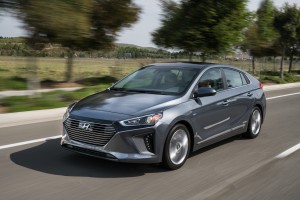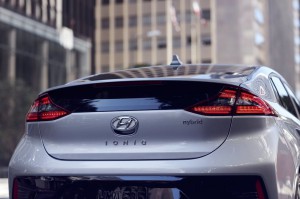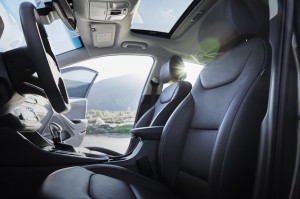
The 2017 Hyundai Ioniq Hybrid is giving the Toyota Prius a serious challenger atop the hybrid mountain.
The automobile industry hybrid segment has been dominated by Toyota for many years and up until now other automakers have mounted what can be best described as half-hearted attempts to challenge the Japanese auto giant’s grip on the category.
However, with the introduction of the Ioniq, Hyundai, the ambitious South Korean automaker, is making a serious bid to gain share in the segment, which promises to grow in the future.
The 2017 Hyundai Ioniq Hybrid also can claim to be the most efficient vehicle on the road even as its new drivetrain also delivers ample power in an all new vehicle with a comfortable interior that also handles nicely, even in a heavy downpour.
The exterior design of the Ionic with its functional lines and clean appearance give the Hyundai Ioniq a contemporary look that turns its five-door shape into a sleek, aerodynamic silhouette with an impressive co-efficient of drag enhanced by the air-flow channels built into the design.
The rear of the Ioniq with its spoiler along the edge of the hatchback utilizes the same clean and simple lines found in the silhouette. The distinctive face of the Ioniq carries traditional Hyundai styling cues and is fine tuned to reduce drag helping boost the vehicle’s combined fuel-economy rating to a most impressive 58 miles per gallon.
The number makes the Ioniq the most fuel-efficient vehicle with a combustion engine now on the road in the U.S.

The rear of the new Ioniq mimics the cars smooth lines and rounded edges helping it to a category best 58 mpg combined.
(Hyundai belatedly plugging in. Click Here for the story.)
The interior ambience of the Ioniq’s cabin is economical. But the seats, dashboard, instrument cluster and center stack are well crafted, giving the driver ready access to key controls as on-board technology with which the car is well equipped.
In addition, there is plenty of room inside the Ionic as well as good visibility from the driver’s seat, which is an important attribute, I think, when driving a smaller vehicle.
The space around the front seat doesn’t feel cramped and there is ample room to stretch thanks to the ample interior volume of 122.7 cubic feet, making it larger than competitors such as the Toyota Prius or Chevrolet Volt.
The extra space increases the overall utility of the vehicle and the rear hatch means the Ionic with its sleek appearance could be a welcome option for someone who might find the standard sport utility vehicle rather boring.
The one drawback is that some of the sound deadening material seems to have been left off the vehicle so that some drivers and passengers might find the cabin noisy. But it is a small vehicle and I found the road noise seeping into the cabin certainly wasn’t enough to impede a conversation or drown out the radio. The interior also features a state-of-the-art infotainment and connectivity features and the instrument cluster is equipped with a high-definition 7-inch TFT.
Hyundai executives describe the Ioniq as the company’s first dedicated platform for alternative energy vehicles. It will also support an electric vehicle and a plug-in hybrid.
(Hyundai wants you to subscribe, not buy, its new Ioniq Electric. Click Here for the story.)

The interior of the new Ioniq hybrid is comfortable and offers plenty of room for front- and rear-seat passengers.
It also means the Ioniq has a number of technically advanced features such as a wheel air curtain and an underbody cover, once found on more expensive vehicles or concept cars. Hyundai also used sugar cane in the process that produced the soft-touch material inside the car.
Overall, one of the Ioniq’s strong points is that the hybrid powertrain does not get in the way of the vehicle’s driving dynamics, which are very solid. The ride is smooth over a variety of pavement thanks to a well-tuned, multi-line rear suspension. The steering was quite responsive, I thought, and the brakes came on quickly even on slick pavement thanks to the re-generative braking system that puts energy back into the Ioniq’s lithium ion battery.
The Ioniq’s drivetrain also responds quickly and on entering a freeway easily gets up to highway speed quickly. The gas/electric power train, with six-speed dual-clutch transmission, can produce 139 net horsepower. The electric motor also is capable of producing 125 ft-lb of torque, while the gasoline engine can contribute 109 ft-lb of torque, giving the vehicle a surge of power, coming away from a stop light, particularly since the Ioniq has curb weight just under 3,000 pounds.
The six-speed transmission also operates quickly and efficiently under varied conditions and seemed to keep pace when the Ioniq we were driving through hilly country along the California coast needed to change gears. In addition, the driver can select either “Sport” or “Eco,” driving characteristics depending on their mood or driving conditions.
Hyundai also equipped the Ioniq with all of the basic safety features such as air bags and a rigid frame to protect occupants in a serious collision and is also making available a full suite of driver assistance features such blind-spot detection, lane-keeping assistance as well as Dynamic Bending Lights and an advanced active safety feature that alerts drivers to emergency situations and that can even brake automatically as required.
The Ioniq is available in three different grades, Blue, SEL and Limited, with prices ranging from $22,200 for the Blue to $27,500 for the Limited plus an $835 destination charge.
(To see more about Hyundai adding a Google Assistant link to its vehicles, Click Here.)
Hybrids, while they have carved out a niche in the market place, haven’t won over the hearts of buyers but the introduction of the Ioniq represents another milestone, and a significant one at that, of the evolution of the hybrid into genuine mainstream product that is fun to drive.

If you like a stepped transmission, this car is for you. It also has a huge basement under the hatchback floor. We test drove the Hyundai Iconiq Blue, the fuel efficient trim, and found it a little louder than our Prius Prime both engine, transmission, and road. If you like audio feedback from your car, this is for you.
Sad to say, the 99.9 maximum MPG indicator means we could not get a fair metrics of miles per gallon. Toyota has already gone to 199.9 and can give a fair metric.
Owning a plug-in Prius Prime and plug-in BMW i3-REx, the Hyundai Ioniq Blue is not tempting. The Ioniqt does not come with dynamic cruise control and accident avoiding which both or our cars have.
Bob Wilson